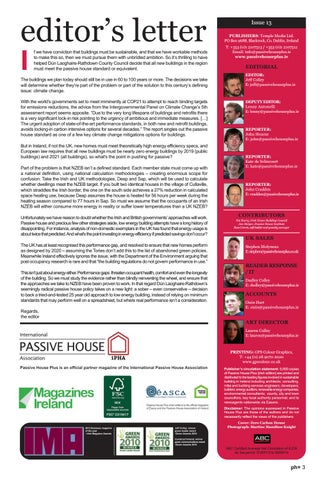editor’s letter I
f we have conviction that buildings must be sustainable, and that we have workable methods to make this so, then we must pursue them with unbridled ambition. So it’s thrilling to have helped Dún Laoghaire-Rathdown County Council decide that all new buildings in the region must meet the passive house standard or equivalent.
The buildings we plan today should still be in use in 60 to 100 years or more. The decisions we take will determine whether they're part of the problem or part of the solution to this century’s defining issue: climate change. With the world’s governments set to meet imminently at COP21 to attempt to reach binding targets for emissions reductions, the advice from the Intergovernmental Panel on Climate Change’s 5th assessment report seems apposite. “Due to the very long lifespans of buildings and retrofits there is a very significant lock-in risk pointing to the urgency of ambitious and immediate measures. […] The urgent adoption of state-of-the-art performance standards, in both new and retrofit buildings, avoids locking-in carbon intensive options for several decades.” The report singles out the passive house standard as one of a few key climate change mitigations options for buildings. But in Ireland, if not the UK, new homes must meet theoretically high energy efficiency specs, and European law requires that all new buildings must be nearly zero energy buildings by 2019 (public buildings) and 2021 (all buildings), so what's the point in pushing for passive? Part of the problem is that NZEB isn’t a defined standard. Each member state must come up with a national definition, using national calculation methodologies – creating enormous scope for confusion. Take the Irish and UK methodologies, Deap and Sap, which will be used to calculate whether dwellings meet the NZEB target. If you built two identical houses in the village of Cullaville, which straddles the Irish border, the one on the south side achieves a 27% reduction in calculated space heating use, because Deap assumes the house is heated for 56 hours per week during the heating season compared to 77 hours in Sap. So must we assume that the occupants of an Irish NZEB will either consume more energy in reality or suffer lower temperatures than a UK NZEB? Unfortunately we have reason to doubt whether the Irish and British governments’ approaches will work. Passive house and precious few other strategies aside, low energy building attempts have a long history of disappointing. For instance, analysis of non-domestic exemplars in the UK has found that energy usage is about twice that predicted. And what's the point investing in energy efficiency if predicted savings don’t occur? The UK has at least recognised this performance gap, and resolved to ensure that new homes perform as designed by 2020 – assuming the Tories don’t add this to the list of abandoned green policies. Meanwhile Ireland effectively ignores the issue, with the Department of the Environment arguing that post occupancy research is rare and that “the building regulations do not govern performance in use.” This isn’t just about energy either. Performance gaps threaten occupant health, comfort and even the longevity of the building. So we must study the evidence rather than blindly reinventing the wheel, and ensure that the approaches we take to NZEB have been proven to work. In that regard Dún Laoghaire-Rathdown’s seemingly radical passive house policy takes on a new light: a sober – even conservative – decision to back a tried-and-tested 25 year old approach to low energy building, instead of relying on minimum standards that may perform well on a spreadsheet, but where real performance isn’t a consideration.
Issue 13 PUBLISHERS: Temple Media Ltd. PO Box 9688, Blackrock, Co. Dublin, Ireland T: +353 (0)1 2107513 / +353 (0)1 2107512 Email: info@passivehouseplus.ie www.passivehouseplus.ie
EDITORIAL EDITOR: Jeff Colley E: jeff@passivehouseplus.ie
DEPUTY EDITOR: Lenny Antonelli E: lenny@passivehouseplus.ie
REPORTER: John Hearne E: john@passivehouseplus.ie
REPORTER: Kate de Selincourt E: kate@passivehouseplus.ie
REPORTER: John Cradden E: cradden@passivehouseplus.ie
CONTRIBUTORS Pat Barry, Irish Green Building Council Jan Steiger, Passive House Institute Ross Cremin, self-builder and quantity surveyor
UK SALES Stephen Molyneux E: stephen@passivehouseplus.co.uk
READER RESPONSE / IT Dudley Colley E: dudley@passivehouseplus.ie
ACCOUNTS Oisin Hart E: oisin@passivehouseplus.ie
Regards, the editor
ART DIRECTOR Lauren Colley E: lauren@passivehouseplus.ie
PRINTING: GPS Colour Graphics, T: +44 (0) 28 9070 2020 www.gpscolour.co.uk Publisher’s circulation statement: 9,000 copies of Passive House Plus (Irish edition) are printed and distributed to the leading figures involved in sustainable building in Ireland including architects; consulting, m&e and building services engineers; developers; builders; energy auditors; renewable energy companies; environmental consultants; county, city and town councillors; key local authority personnel; and to newsagents nationwide via Easons. Disclaimer: The opinions expressed in Passive House Plus are those of the authors and do not necessarily reflect the views of the publishers. Cover: Zero Carbon House Photograph: Martine Hamilton Knight
ABC Certified Average Net Circulation of 6,236 for the period 01/07/13 to 30/06/14
ph+ 3
